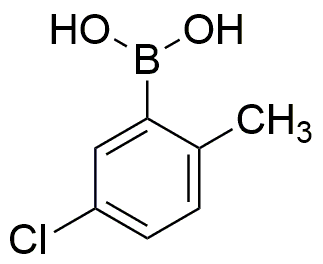5-Chloro-2-methylphenylboronic acid is widely utilized in research focused on:
- Organic Synthesis: This compound serves as a key intermediate in the synthesis of various pharmaceuticals and agrochemicals, allowing chemists to create complex molecules efficiently.
- Cross-Coupling Reactions: It plays a crucial role in Suzuki-Miyaura coupling reactions, which are essential for forming carbon-carbon bonds in organic chemistry, particularly in the development of new materials and drugs.
- Bioconjugation: The boronic acid functional group enables selective binding to diols, making it useful in bioconjugation techniques for labeling biomolecules, which is valuable in diagnostics and therapeutic applications.
- Sensor Development: This compound is used in the fabrication of sensors that detect glucose levels, benefiting the medical field by providing a means for continuous monitoring of diabetic patients.
- Material Science: It is utilized in the development of polymeric materials with enhanced properties, such as improved thermal stability and mechanical strength, which are important in various industrial applications.
General Information
Properties
Safety and Regulations
Applications
5-Chloro-2-methylphenylboronic acid is widely utilized in research focused on:
- Organic Synthesis: This compound serves as a key intermediate in the synthesis of various pharmaceuticals and agrochemicals, allowing chemists to create complex molecules efficiently.
- Cross-Coupling Reactions: It plays a crucial role in Suzuki-Miyaura coupling reactions, which are essential for forming carbon-carbon bonds in organic chemistry, particularly in the development of new materials and drugs.
- Bioconjugation: The boronic acid functional group enables selective binding to diols, making it useful in bioconjugation techniques for labeling biomolecules, which is valuable in diagnostics and therapeutic applications.
- Sensor Development: This compound is used in the fabrication of sensors that detect glucose levels, benefiting the medical field by providing a means for continuous monitoring of diabetic patients.
- Material Science: It is utilized in the development of polymeric materials with enhanced properties, such as improved thermal stability and mechanical strength, which are important in various industrial applications.
Documents
Safety Data Sheets (SDS)
The SDS provides comprehensive safety information on handling, storage, and disposal of the product.
Product Specification (PS)
The PS provides a comprehensive breakdown of the product’s properties, including chemical composition, physical state, purity, and storage requirements. It also details acceptable quality ranges and the product's intended applications.
Certificates of Analysis (COA)
Search for Certificates of Analysis (COA) by entering the products Lot Number. Lot and Batch Numbers can be found on a product’s label following the words ‘Lot’ or ‘Batch’.
Número de catálogo
Número de lote/lote
Certificates Of Origin (COO)
This COO confirms the country where the product was manufactured, and also details the materials and components used in it and whether it is derived from natural, synthetic, or other specific sources. This certificate may be required for customs, trade, and regulatory compliance.
Número de catálogo
Número de lote/lote
Safety Data Sheets (SDS)
The SDS provides comprehensive safety information on handling, storage, and disposal of the product.
DownloadProduct Specification (PS)
The PS provides a comprehensive breakdown of the product’s properties, including chemical composition, physical state, purity, and storage requirements. It also details acceptable quality ranges and the product's intended applications.
DownloadCertificates of Analysis (COA)
Search for Certificates of Analysis (COA) by entering the products Lot Number. Lot and Batch Numbers can be found on a product’s label following the words ‘Lot’ or ‘Batch’.
Número de catálogo
Número de lote/lote
Certificates Of Origin (COO)
This COO confirms the country where the product was manufactured, and also details the materials and components used in it and whether it is derived from natural, synthetic, or other specific sources. This certificate may be required for customs, trade, and regulatory compliance.


